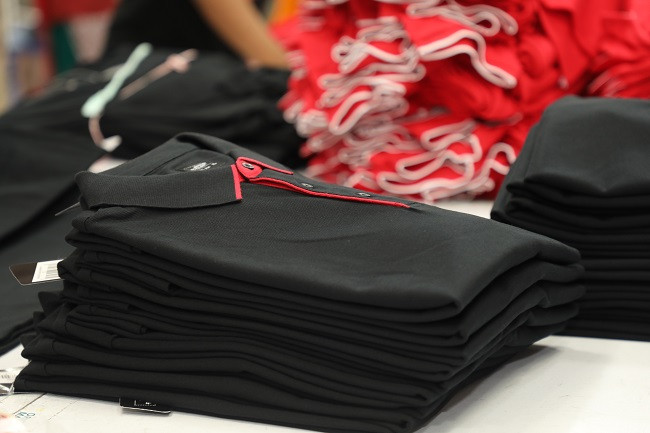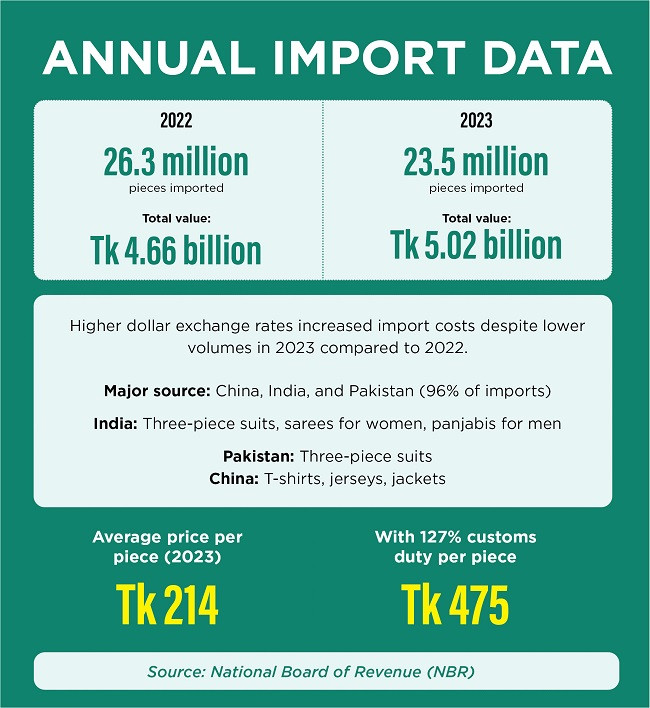Bangladesh, the world’s second-largest apparel exporter, paradoxically imports ready-made garments worth approximately Tk 5 billion annually, primarily from India, Pakistan, and China.

According to the National Board of Revenue (NBR), Bangladesh legally imported 23.5 million pieces of ready-made garments last year, with a total value of nearly Tk 5.02 billion. This marked a decrease in volume but increase in value from 2022, when 26.3 million pieces were imported at a cost of Tk 4.66 billion. The higher costs despite the lower volume last year were attributed to the elevated exchange rate of the dollar, which increased import expenses.
In the first three months of this year alone, Bangladesh imported a staggering 7.5 million pieces of clothing, amounting to Tk 2.14 billion. Bangladesh imports three-piece suits and sarees for women, and panjabis for men mostly from India, while Pakistan supplies mainly three-piece suits. From China, imports include T-shirts, jerseys, and jackets.
The NBR reports that the average price per imported garment last year was Tk 214. After adding a 127% customs duty, this price increased to Tk 475.
Despite the strong presence of local fashion brands and boutique houses, this heavy reliance on imports undermines the potential of the domestic market. To reduce these imports and bolster local production, several strategic measures are necessary.
Strengthening local production capabilities
First and foremost, enhancing the capacity and quality of local garment manufacturing is crucial. Bangladesh’s garment sector is already a global powerhouse, exporting more than $47 billion worth of textiles in 2022. Leveraging this expertise, local manufacturers should focus on diversifying product lines to cater to domestic tastes and preferences. Investing in modern technology and skilled labor can further improve the quality and variety of locally produced garments, making them more appealing to Bangladeshi consumers.
Government incentives and support
Government support is pivotal in reducing apparel imports. Implementing policies that provide incentives for local manufacturers can significantly boost domestic production. For instance, increasing subsidies for locally produced garments and reducing taxes on raw materials would lower production costs. Additionally, providing low-interest loans and grants for technological upgrades and expansion projects can empower local businesses to scale up their operations.
The government should also consider increasing import duties on finished garments while providing tax breaks or incentives for using locally sourced materials. This dual approach would make imports less attractive while encouraging local production. Strict enforcement of import regulations is necessary to curb illegal imports that further undermine the local industry (The Business Standard).
Enhancing supply chain efficiency
Improving the efficiency of the local supply chain is essential. The Bangladesh textile industry often faces challenges related to raw material procurement and logistics. Addressing these issues through better infrastructure and streamlined processes can reduce production delays and costs. The establishment of textile hubs and industrial zones with integrated supply chains can facilitate smoother operations and lower logistical hurdles.
Promoting local brands
Raising awareness and promoting local fashion brands can also play a significant role in reducing imports. Marketing campaigns highlighting the quality, affordability, and unique designs of Bangladeshi garments can shift consumer preferences towards local products. Collaborations with local designers and fashion influencers can help create a stronger brand identity and increase the appeal of domestic apparel.

Moreover, initiatives such as fashion shows, trade fairs, and digital marketing can showcase the talent and creativity of Bangladeshi designers, fostering a sense of national pride and encouraging consumers to support homegrown brands.
Encouraging sustainable practices
Sustainability is becoming increasingly important in the global apparel industry. By adopting eco-friendly practices and emphasizing sustainable production, Bangladeshi manufacturers can attract environmentally conscious consumers. Government policies that promote sustainable practices, such as providing subsidies for eco-friendly materials and processes, can further enhance the competitiveness of local garments.
Addressing raw material challenges
One of the significant hurdles for the local textile industry is the dependency on imported raw materials. To mitigate this, the government should encourage the cultivation and production of raw materials within the country. Research and development in high-yield cotton varieties and other raw materials can reduce reliance on imports and stabilize the supply chain.
Additionally, fostering partnerships with local suppliers and investing in modern agricultural practices can improve the quality and availability of raw materials, thereby supporting the local textile industry.
In fine, reducing apparel imports and meeting domestic demand with locally made garments requires a multi-faceted measures. These measures will not only support the local economy but also create jobs and foster a robust, self-sufficient garment industry. The collaboration between the government, industry stakeholders, and consumers is crucial to realizing this vision and ensuring the long-term sustainability of Bangladesh’s apparel sector.
















